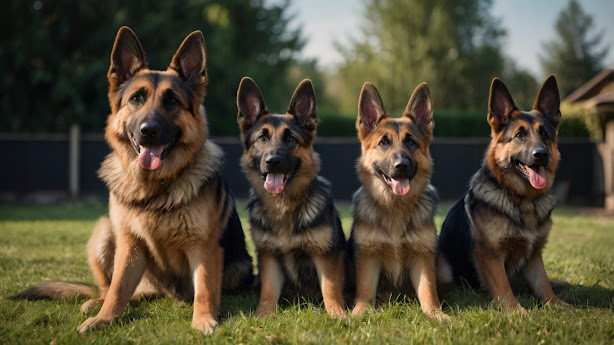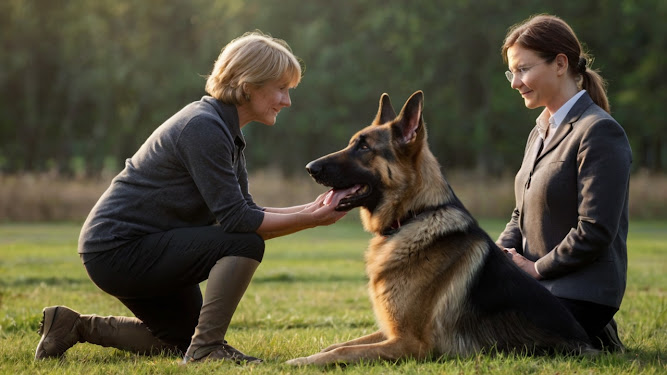Have you ever locked eyes with a stunning German Shepherd and felt an instant connection? These intelligent, loyal, and versatile dogs have captured hearts around the world for over a century. But there's more to these great canines than meets the eye.
From their origins as sheep herders to their modern roles as police dogs, service animals and beloved family pets, German Shepherds have proven time and time again that they are not just any breed. Their unwavering loyalty, keen intelligence, and impressive adaptability make them stand out in the canine world. 👑🐕 But owning a German Shepherd isn't all tailwag and fetch games. These powerful dogs require dedicated care, training and understanding to truly thrive.
In this comprehensive guide, we'll explore the fascinating world of German Shepherds. From their distinctive characteristics and rich history to their various roles in society and the essentials of caring for them, we'll cover everything you need to know about these remarkable dogs. Whether you're a longtime German Shepherd owner or just considering bringing one into your life, get ready to immerse yourself.
Characteristics of German Shepherds
German Shepherds are known for their outstanding traits, making them one of the most popular dog breeds worldwide. Let's explore their key features:
A. Physical attributes
German Shepherds are large, muscular dogs with a distinctive appearance:
Height: 22-26 inches (55-65 cm)
Weight: 50-90 pounds (22-40 kg)
Coat: Double-layered, with a dense outer coat
Colors: Various, including black and tan, sable, and solid black
Feature | Description |
|---|---|
Ears | Large, pointed, and erect |
Tail | Long and bushy, often curved |
Body | Strong, well-proportioned frame |
B. Loyalty and protective nature
German Shepherds are known for their unwavering loyalty and protective instincts:
Form strong bonds with their families
Naturally alert and watchful
Excellent guard dogs and protectors
C. Intelligence and trainability
These dogs are highly intelligent and eager to learn:
Ranked as one of the smartest dog breeds
Quick to understand and follow commands
Excel in various training disciplines, including obedience and agility
D. Temperament and personality
German Shepherds have a well-balanced temperament:
Confident and self-assured
Generally calm and composed
Playful and energetic when appropriate
May be reserved with strangers but not aggressive when properly socialized
Their versatile nature makes them suitable for a variety of roles, from family companions to working dogs. With proper training and socialization, German Shepherds can adapt well to different environments and lifestyles.
History and Origin
German Shepherds have a rich and interesting history that spans over a century. Let's explore their origin and development.
Notable German Shepherds in History
German Shepherds have played important roles throughout history, particularly in military and law enforcement roles. Here are some notable examples:
Rin Tin Tin: A famous canine actor who appeared in 27 Hollywood films, popularizing the breed in America
Filax of Lewanno: Credited with saving 54 lives during World War I
Appollo: One of the first search and rescue dogs at Ground Zero after the 9/11 attacks
Original purpose
The German Shepherd was initially bred for a specific purpose:
Purpose | Description |
|---|---|
Herding | Originally developed to herd and protect sheep |
Versatility | Designed to be an all-purpose working dog |
Intelligence | Bred for high intelligence and trainability |
Development of the breed
The German Shepherd breed as we know it today was developed by Captain Max von Stefanitz in the late 19th century. Here is a brief timeline of the generation's development:
- 1899: Von Stephanitz bought a dog named Hector Lancaster.
- Hector was renamed Horand von Grafrath and became the first registered German Shepherd.
- Von Stephanitz founded the Society for German Shepherd Dogs (Verein für Deutsche Schäferhunde).
- Breed standards are created with an emphasis on intelligence, strength and utility.
- German Shepherds gained popularity as police and military dogs during World War I.
- The breed spreads globally, becoming one of the most popular dog breeds worldwide.
German Shepherds as Working Dogs
German Shepherds are known for their versatility and intelligence, making them exceptional working dogs in a variety of fields. Their strength, agility and trainability have made them indispensable in many professional roles. Bringing a German Shepherd puppy into your home is an exciting and rewarding experience. These pups are renowned for their intelligence, loyalty, and energy. A German Shepherd puppy quickly becomes a devoted family member, showcasing a natural curiosity and eagerness to learn. Their trainability makes them ideal for various activities, from obedience training to agility courses.
A. Herding and farm work
German Shepherds excel in their original purpose as herding dogs. Their natural instincts and intelligence make them ideal for:
Gathering and moving livestock
Protecting farm animals from predators
Assisting with general farm tasks
Task | German Shepherd Qualities |
|---|---|
Herding | Agility, stamina, intelligence |
Livestock protection | Alertness, courage, loyalty |
Farm assistance | Trainability, strength, versatility |
B. Service and assistance dogs
German Shepherds are frequently chosen as service and assistance dogs due to their:
High intelligence and trainability
Loyalty and dedication to their handlers
Ability to perform complex tasks
They often serve as:
Guide dogs for the visually impaired
Mobility assistance dogs
Seizure alert dogs
C. Search and rescue operations
The German Shepherd's keen sense of smell, endurance, and agility make them invaluable in search and rescue missions:
Locating missing persons in wilderness areas
Finding survivors in disaster zones
Avalanche rescue operations
D. Police and military roles
German Shepherds are a top choice for law enforcement and military units worldwide. Their roles include:
Patrol and apprehension of suspects
Narcotics and explosives detection
Crowd control and riot response
These versatile dogs continue to prove their worth in a variety of working roles, demonstrating their adaptability and intelligence. Their success in these areas is a testament to the breed's exceptional qualities and the strong bond they have with their handlers..
Care and Maintenance
Now that we've explored the working roles of German Shepherds, let's review their care and maintenance needs to ensure they stay healthy and happy.
A. Exercise requirements
German Shepherds are high-energy dogs that require regular exercise to maintain their physical and mental health. Here's a breakdown of their exercise needs:
Daily walks: At least 1-2 hours of brisk walking or jogging
Mental stimulation: Puzzle toys, scent work, or obedience training
Playtime: Fetch, tug-of-war, or agility exercises
Swimming: An excellent low-impact exercise option
B. Health concerns and preventive care
While generally healthy, German Shepherds are prone to certain health issues. Regular check-ups and preventive care are crucial:
Health Concern | Preventive Measure |
|---|---|
Hip dysplasia | Regular exercise, maintaining healthy weight |
Bloat | Feeding smaller meals, avoiding exercise after eating |
Degenerative myelopathy | Genetic testing, regular neurological exams |
Allergies | Identifying triggers, proper diet |
C. Nutritional considerations
A balanced diet is essential for a German Shepherd's health and longevity:
High-quality protein sources (meat, fish)
Complex carbohydrates for energy
Omega-3 fatty acids for coat and joint health
Appropriate calcium levels for bone strength
Portion control to prevent obesity
D. Grooming needs
German Shepherds have a double coat that requires regular grooming:
Brushing: 2-3 times a week, daily during shedding seasons
Bathing: Every 4-6 weeks or as needed
Nail trimming: Monthly or as required
Teeth cleaning: 2-3 times a week for optimal dental health
Ear cleaning: Weekly to prevent infections
By paying attention to these aspects of care and maintenance, you will ensure that your German Shepherd is in top condition. Next, we'll explore effective training techniques for these intelligent and loyal companions.
Training a German Shepherd
German Shepherds are highly intelligent and trainable dogs, making them excellent candidates for a variety of roles. However, proper training is essential to harness their potential and ensure that they become well-behaved companions. Let's explore some important aspects of training these wonderful dogs.
Common training challenges and solutions
German Shepherds can present unique training challenges due to their intelligence and strong will. Here are some common problems and solutions:
Stubbornness: Use positive reinforcement and consistency
Excessive energy: Incorporate mental stimulation exercises
Prey drive: Teach a reliable "leave it" command
Separation anxiety: Gradually increase alone time and provide engaging toys
Advanced training for specific tasks
German Shepherds excel in various roles due to their versatility. Here's a comparison of advanced training for different tasks:
Task | Training Focus | Time Commitment |
|---|---|---|
Police work | Scent detection, apprehension | 12-16 months |
Search and rescue | Tracking, agility | 18-24 months |
Service dog | Task-specific skills, public behavior | 18-24 months |
Competitive obedience | Precision commands, off-leash control | 6-12 months |
Socialization techniques
Proper socialization is crucial for German Shepherds to develop into well-rounded adults. Here are some effective techniques:
Expose to various environments, people, and animals from an early age
Attend puppy classes and organize playdates
Use positive experiences to build confidence
Gradually introduce new stimuli to prevent overwhelming the dog
Basic obedience training
Establishing a strong foundation in basic obedience is essential for German Shepherds. Focus on these core commands:
Sit
Stay
Come
Heel
Down
Consistency, patience, and positive reinforcement are the keys to successfully training a German Shepherd. With proper training, these dogs can become exceptional working partners and loving family members. Now that we've covered training techniques, let's explore how German Shepherds fit into family life.
German Shepherds as Family Pets
German Shepherds can make excellent family pets, but there are a number of factors to consider before bringing one into your home. Let's examine the pros and cons, space requirements, and their compatibility with other pets and children.
A. Pros and cons of owning a German Shepherd
Pros | Cons |
|---|---|
Loyal and protective | High exercise needs |
Intelligent and trainable | Prone to separation anxiety |
Great with children | Heavy shedders |
Versatile and adaptable | May be aloof with strangers |
B. Space and lifestyle requirements
German Shepherds are large, active dogs that require ample space and a commitment to their exercise needs. They thrive in homes with:
Large, securely fenced yards
Access to daily walks and playtime
Mental stimulation through training and interactive toys
An active family lifestyle
C. Interaction with other pets
German Shepherds can generally get along well with other pets when properly socialized. However, consider the following:
Early socialization is crucial
They may have a strong prey drive towards smaller animals
Same-sex aggression can occur, especially with other large dogs
Supervision is necessary during initial introductions
D. Compatibility with children
German Shepherds are known for their gentle nature and protective instincts towards children. They can be excellent companions for kids, but it's important to:
Teach children how to interact safely with dogs
Supervise interactions, especially with young children
Socialize the German Shepherd from puppyhood
Provide proper training to ensure obedience and good manners
With proper care, training, and socialization, German Shepherds can become loving and loyal family members, forming strong bonds with both adults and children alike. Now that we've covered their suitability as family pets, let's explore the essential aspects of training a German Shepherd to ensure they become well-behaved and obedient companions.
Whether you're considering a German Shepherd as a working partner or a family companion, it's important to understand the commitment required. Proper training, regular exercise, and constant grooming are essential to raising a well-balanced and happy German Shepherd.

.jpg)




.jpg)





0 Comments